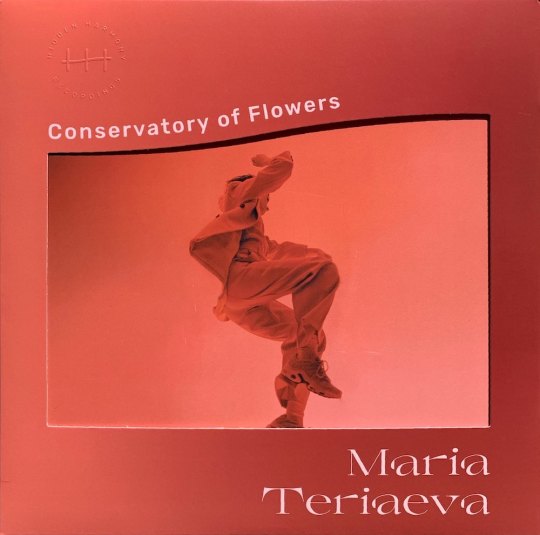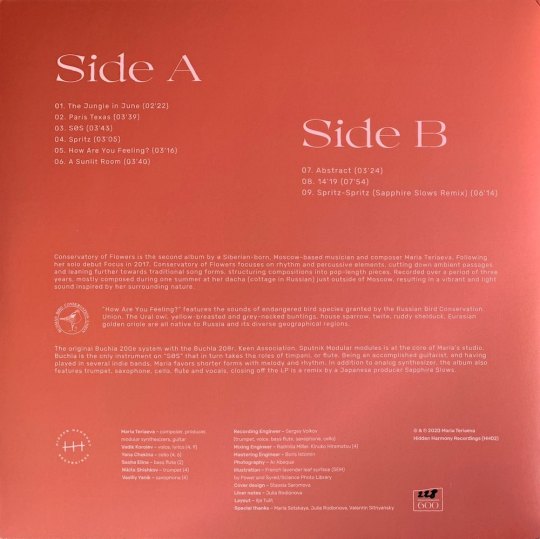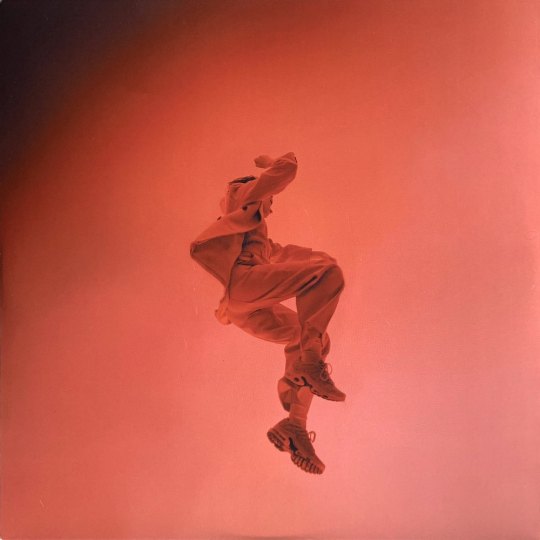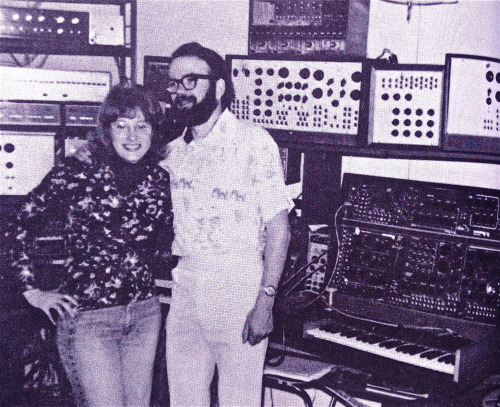#buchla
Wiring a Triple LPG for MOTM/5U format

Priscilla and Barton McLean.
From the book The Electronic Arts Of Sounds And Lights by Ronald Pellegrino
Post link
David FirstElectronic Works 1976-1977(Buchlainsanity!)
fromDais Records
Sampleshere.
“When people associate composer David First with his musical resume, anyone goes straight to his late 70′s avant punk band, The Notekillers and their influential 1980 single The Zipper. Prior to his time in the basements of Philadelphia, he had already played in Cecil Taylor’s ensemble and after the Notekillers broke up he moved to New York City in the early 80′s, taking root in the downtown NYC avant garde scene. It was there that First honed his craft for experimental composition and ambient drone which still continues to the present day.
Though this narrative made sense, there was a piece missing in the puzzle of First’s musical background. In 1976, two years after playing with Taylor and the year before starting the Notekillers, he enrolled in a class in electronic music at Princeton in the department headed at the time by legendary electronic composer Milton Babbitt.
During his time at Princeton, First was introduced to the classical electronic music studio there, a lonely outpost of the famed Columbia-Princeton Electronic Music Center which housed one of the very first Buchla 100 series systems acquired by Vladimir Ussachevsky & Otto Luening.
Unfortunately, due to the introduction of digital technology within the music world, this system was left to languish in the studio unattended and nearly forgotten. First fell in love with this equipment and seized the opportunity to compose using the Buchla 100 synthesizer, at first experimenting only with electronic synthesis but later adding in his signature guitar stylings to make these compositions unique to the academic output typical of university music.
Thankfully, these compositions were recorded by First at Princeton on various reel to reel tapes and stored away for over 35 years. It wasn’t until the summer of 2012, when David First and Ryan Martin (of Dais Records) decided to revisit and transfer these reels to compile an album presented here as a selection of genuine, uninhibited exploration into modular electronic synthesis. Limited to an edition of 500 copies with liner notes by David First.”
Marc Masters Pitchfork review here.
Post link
Noisemakers
.
.
#manhattananalog #buchla #toppobrillo #steffensen #eurorack #synthporn #robboten #808
https://www.instagram.com/p/BuwwptclsTD/?utm_source=ig_tumblr_share&igshid=j5xe3ttto8dy
Post link
Having reviewed Morita Vargas’ 8 a few weeks ago, I’ll now turn my attention towards another standout release from Hidden Harmony Recordings, which is Maria Teriaeva’s Conservatory of Flowers. As her main tool, Teriaeva employs a Buchla 200e modular system, and throughout Conservatory of Flowers, she wrestles and wrangles some incredible tones from this singular synthesizer palette. Though the LP additionally features field recordings, bass flute, cello, trumpet, sax, guitar, and voice, you’d be forgiven for thinking there were mallet instruments and thumb pianos, timpanis and tubas, seed shakers and hand drums, and much else besides, for Teriaeva configures her sorcerous electronics into a polychromatic display of instrumental emulation. Which is not to say that the Buchla isn’t also used for purposes of angelic ambient, sci-fi strangeness, or dissonant drone, and indeed, the compositions here are as experimental as they are immediate, as Teriaeva and her collaborators weave together threads of avant-garde sound design into concise song structures that are at once madcap and dexterous, and that turn often and unexpectedly into far out sonic realms…with passages of futurist forest folk or deviant pop ecstasy plunging suddenly into shadowy abysses of strings and bass synthesis, only to then rush back towards the light. Taking in the full experience, my mind drifts to Kate NV, to Ryuichi Sakamoto, and to Yasuaki Shimizu, though there is a level of gleeful experimentation on display that also evokes the works of Museum of Modern Art, Georgia, and Michelle Mercure. But these are only vague signposts, and in truth, the sonic world of Conservatory of Flowers is utterly unique…a rhythmic and percussive paradise of organic instrumentations and exotic synthesizer colorations that only gets more compelling—and more strange—with each listen. And though the original tracks are great enough, the album also includes a gonzo remix of “Spritz” from Sapphire Slows, which stitches together chopped vocals, stuttering house beats, funk basslines, and mutating rave chords into an anxious expanse of alien club euphoria.
Maria Teriaeva - Conservatory of Flowers (Hidden Harmony Recordings, 2020)
“The Jungle in June” opens the album with panning clicks evoking crystalline insect wings, flowing layers of underwater ambiance, and gemstones melting in place as they merge with shimmering clouds of ether. Kalimba and marimba tones sourced from Teriaeva’s Buchla join together with sub bass percolations that inhabit a zone between kick drum and bassline, and subtle pitch shifts send lysergic wavefronts through the air. As the deep sea ambiance recedes, it is replaced by gusts of granular wind, and all around, modular idiophones and hyperspeed panning effects dance together, with the mix minimal, spacious, and leaving plenty of room for a ceremonial beat to work the body. And at the end, pallid pads glow in oceanic hues while hovering in place, holding to no particular key until the whole mix disappears in a flash. Broken transmissions and twinkling metals introduce “Paris Texas,” with everything moving back and forth across the stereo field at varying speeds. Melodies attempt to form and subtle progressions are hinted at within the sparkling drone clouds; reverberating fx trail off through guttural breaths and demented echoes; and somewhere in the murk sits the bass flute of Sasha Elina, though it merges in totality with Teriaeva’s modular sound maze. What then develops is a world of polyrhythmic magic, with a multitude of sequences and woodwinds pinging left to right while accelerating in tempo. The sonic spectrum overflows with lightspeed pulsations and flourishes of minimalist magic, with machines hissing like snake tails and crazed idiophone patterns careening at random…like a drunken cloud of cicadas moving according to no particular logic. And at some point the mix seems to reduce slightly in intensity, which gives space to alien frog croaks and mysterious hints of voice.

Rainbow-hued squelches dance at the start of “SØS” and dissonant blasts of metalloid haze slowly resolve into a tuba-esque progression. Starshine sequences and electronics like malfunctioning bird calls enter the stereo field as the piece settles into a drunken waltz, one led by a two-note bassline that lands with Lynchian energy…think 50s pop slowed to a dopamine crawl. As the bass groove disperses, space is left for synthetic percussions to pop and sickly leads to buzz amidst wisps of galactic light, and after the track changes vibe once more, dramatic and Buchla-generated idiophone descents join ceremonial drums while outer-dimensional liquids wash all around. Shifting again, we return to seasick sequencing and that Twin Peaks-indebted bassline, which sets up a magical merging of the various pieces of the song…a madcap layering of waltzing 50s sci-fi mesmerism built from squelching synths and squarewave bass throbs, rainforest percussions and modular mallet melodies, and melting streaks of starshine…the result an abstract dance of alien balearica, which is not unlike the weirder works of artists such as Pharaohs, Stratus, and Shelter. Next comes “Spritz,” which starts with cello strings bowing in hypnotic ecstasy before the mix explodes, seeing Vasiliy Yanik’s saxophone and Nikita Shishkov’s trumpet snaking in celebration through the manic choir vocalizations of Vadik Korolev…the whole thing pulling my mind to the work of Yasuaki Shimizu. A sharp transition cuts the track down to splattered and heavily effected string clatter, pounding bass, and reverberating snap patterns as hints of the euphoric sound orgy preceding start building back in strength. Horns converse and bowed cellos generate sunrise colorations before devolving into a shimmering display of spectral metal, and eventually, the manic Shimizu-style avant pop dance returns in full strength. But just as quickly, the track breaks down again…back to the world of broken electro-string skitter, ritualized percussion, and expressive sax, trumpet, and string accents. The vocals build around with wondrous “AY-YA-YA” chants until the spectrum is overwhelmed by sheets of percussive detritus, and after devolving further towards masculine breathing and wheezing whooshes of neon static, Yana Chekina’s cello detunes wildly while scraping and crawling towards the sky.

In “How Are You Feeling?” percussive sequences tick through cut up samples sourced from the Russian Bird Conservation Union, with the whole thing sounding like a transmission from some broken satellite. Synthetic water drums pan across the spectrum while holding a hypnotizing body flow and strange melodies are carried by blinding currents of feedback and searing sonar blips. At once the vibe changes, seeing detuning waves of orchestral synthesis billow out from the center of the universe in a way that recalls the terrifying kosmische expanses of Klaus Schulze’s Irrlicht,or perhaps Tangerine Dream’s Zeit. Then, following this expanse of viscous darkness, we suddenly return to a jungle of peace and light, wherein birds resume singing amidst insect chatter while idiophones play lullabies to the rising sun. Sub bass currents move with propulsive energy and crazed comets streaks across the sky as the body swings back and forth in a state of mirth, though touches of melancholy softly kiss the melodic progressions. “A Sunlit Room” closes the first side with bowed strings and clattering clouds of madness that soon give way to an Afro-folk synth bounce, which is accented by fizzing bodies of liquid effervescence. Strange echo trails skitter down reverberating hallways and morphing blasts of air land throughout the spectrum as the main synth progression filters wildly and eventually, the songs seems to fall apart while simultaneously increasing in intensity, as Yana Chekina’s bowed cello strings underly layers of bouncing melodic mesmerism…a child-like hook that works itself deep into the brain and again evokes Yasuaki Shimizu, though Teriaeva’s concoction is altogether stranger than anything he might compose. Higher pitched electronics move with hesitation, percussive layers like the motions of nervous insects wash across the mix, and those Afro-kosmische synths again filter out of control while bouncing bleeps and bloops drop like globules of starlight. Then following a pause, there’s an explosion of bowed strings and bass electronics, which together execute an alien dream dance within a world of panning rhythmic skitter and anxious radar accents…all as white noise winds blow and liquids vaporize into polychrome ether.

The B-side opens with “Abstract” and its cavernous spaces suffused through by twinkling crystals and glimmering alloys. Percussive accents shift in pitch…their effect like liquids dripping into neon pools…and a shadowy hand drum rhythm builds up as the sparkling sound cascades lessen in magnitude, while also locking into the rhythmic flow. What emerges is something not unlike Vague Imaginaires’ “L'essor du roraima,” especially as we settle deeper into a slow and low tribal drum ritual overlaid by clouds of futurist magic, wherein polyrhythmic metals are structured into a brain-bending flow. Dissonant sirens emerge from the distance, wavering cascades of mutating light melt upon the mix, and a pounding bass drum holds down the beat through layers of feverish delirium before the track breaks apart, leaving sickly wavefronts of droning skree and currents of nacreous noise to merge into a malarial fog. Next comes “14’19” and its clockwork sequences, which morph through maddening fx that spread and pan the sounds into psychedelic zooms and spectral whooshes. The sequential patterns take on a rougher and noisier tone as pitch-bending sirens enter the stereo field, and eventually, everything settles into a harmonious wall of droning chords that periodically detunes…the effect creating waves of warbling wow’n’flutter that spread out towards infinity. Delay feedback manipulations generate industrial screams and dizzying whirlpools that surround the spirit, and as the piercing sirens tones pulse continuously in one ear, their decay trails are caught and reversed in the other. Billowing blankets of distorted synthesis bend towards dissonance before dispersing and eventually, the song changes in vibe, seeing mutating sequences bounce joyously back and further under heavy filtering and modulation…the motions and tones causing the mind and body to lose all sense of space-time. Pads awash in orchestral majesty hover in place before plunging down in pitch, and flubby brass arps emerge then cut away as we return to the introductory world of ticking sequences and searing siren screams.

A long stretch of silence leads to a secret track, which features FM bells decaying in the wrong direction alongside subtle clusters of industrial breath. Methodic bass patterns and the patient beat of a subaquatic drum are at odds with the anxious bodies of chaos swirling up above,..these howls of metallic noise and drone that merge into a discontinuous storm cloud, wherein evocations of things heard before now modulate, distort, and flow backwards in time. As well, the end of the B-side also contains a special remix of “Spritz” by Sapphire Slows. Entitled “Spritz-Spritz,” the track begins with detuning sirens blasts and swelling vortices of vibration, while snaps hold down a sparse rhythm. Cyborg string plucks spread out into fractal structures, bulbous basslines move underneath the flow, and a kick drum adds a body-bobbing club energy as spacey sequences descend then disperse. Double-time cymbals flow in from silence and ricocheting dub flourishes wash side to side…the vibe low slung and delirious, especially as snares drop at the end of each measure. Rhythms pull away as psychotic rave chords pitch-shift and pulse overhead, and the vocals of Vadik Korolev are cut up and repurposed amidst popping percussive sequences. The kick drum returns—though now the beat stutters anxiously through abstracted fogs of snare—and eventually, a start/stop hypno-rhythm takes over, led by slinky funk basslines, ticking shaker tones, and conglomerations of oscillation that seem to bubble up from sub-earthen depths. Blistered leads burn across the mix as the vocals pull away, leaving behind a strange world of animalistic synthesis. And when the cut-up choral accents return, they pulse in tandem with the militant flow of detuning rave chords…the result another expanse of club delirium, though as before, the vibe is angular, off-kilter, and increasingly extra-terrestrial.
(images from my personal copy)
ALICE SHIELDS -“STUDY FOR VOICE AND TAPE” (1968) (by funknroll)
Early electronica: Buchla lines, tape manipulation and an original vocal line by Alice herself.



